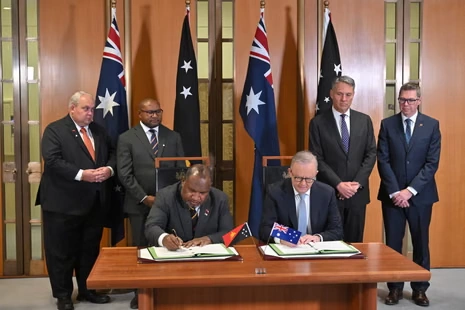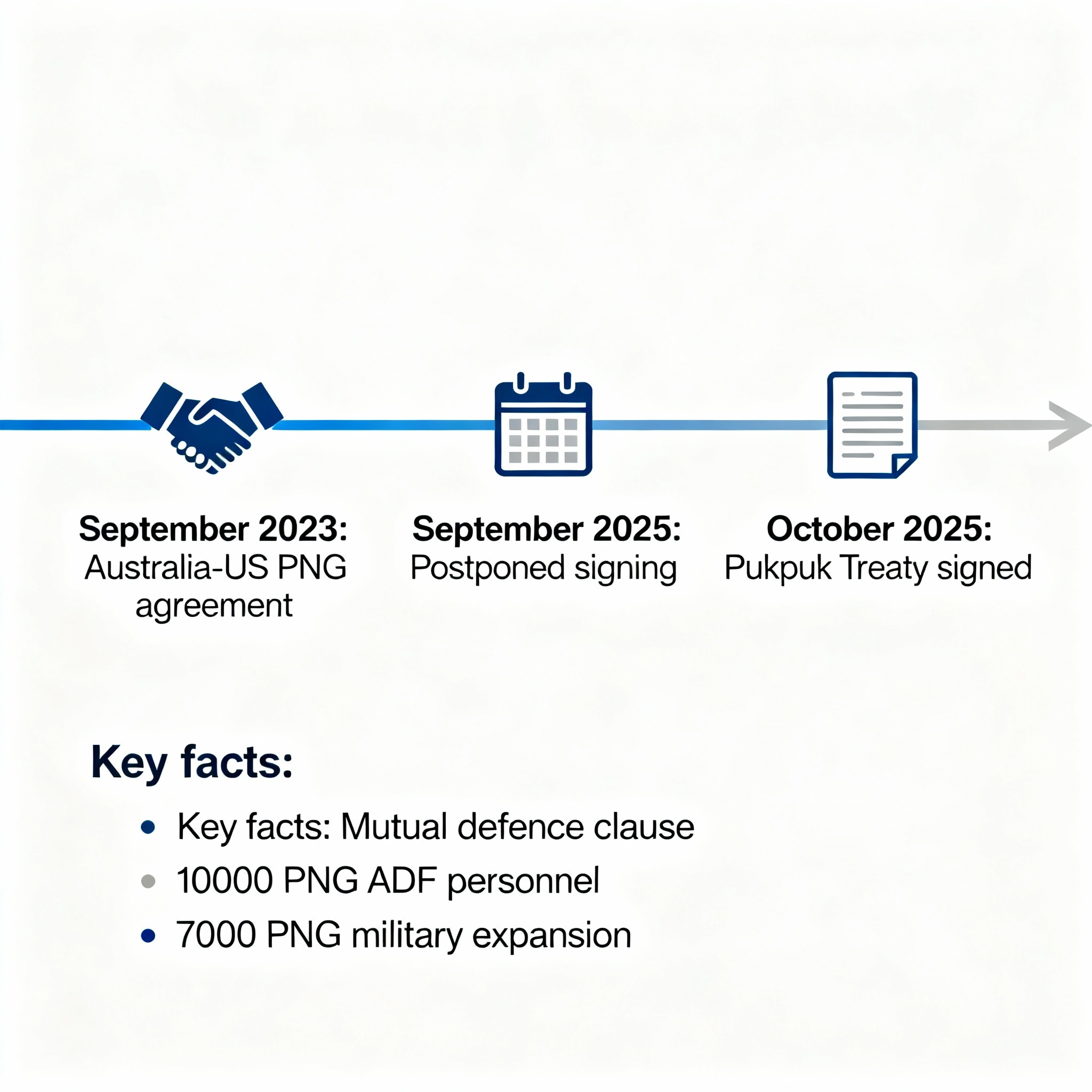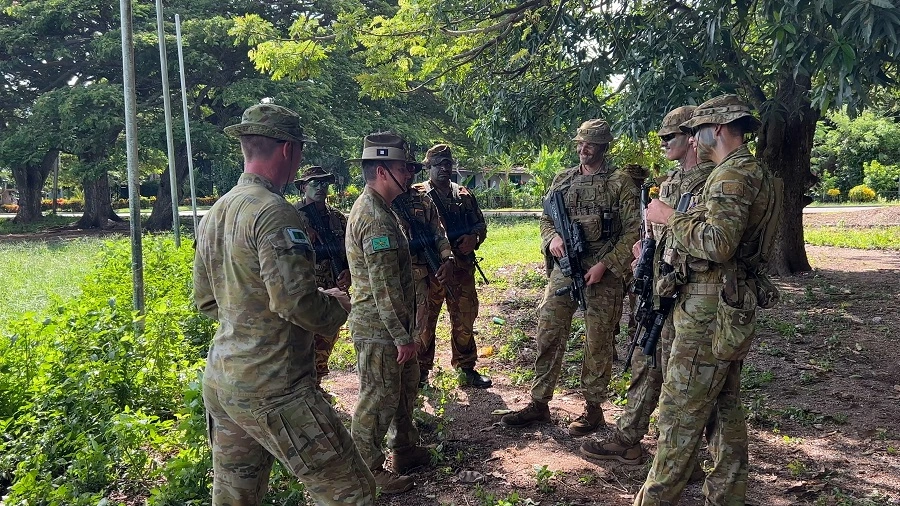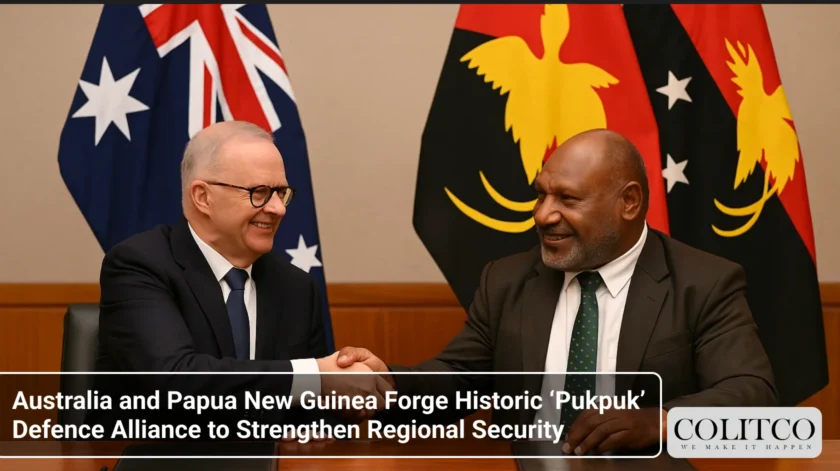Australian Prime Minister Anthony Albanese and Papua New Guinea Prime Minister James Marape signed the Pukpuk Treaty at Parliament House in Canberra on Monday. Ministers from both countries attended the ceremony and applauded the signing. The name “Pukpuk” comes from the Tok Pisin word for crocodile, symbolising strength and shared heritage.
Anthony Albanese and James Marape sign the Pukpuk defence treaty at Parliament House in Canberra
Background and Context
The agreement follows a postponed signing in Port Moresby in September, when PNG celebrated its 50th year of independence but lacked cabinet approval for the treaty. This new defence treaty marks Australia’s first alliance in more than 70 years and only the third in its history, alongside partnerships with the United States and New Zealand.
Treaty Provisions
The treaty establishes a mutual defence clause, requiring both nations to support each other if either faces an armed attack. Prime Minister Albanese said, “This is a landmark agreement. By enhancing our security partnerships within the region, we protect our own safety”. PNG Prime Minister Marape added, “This Treaty was not born out of geopolitical strategies or other motives, but rather from our geography, history, and the lasting reality of our shared neighbourhood”.
Both countries agreed not to enter into other agreements that undermine the execution of this treaty. The treaty allows up to 10,000 Papua New Guineans to serve in the Australian Defence Force under dual arrangements. PNG will expand its own military to a force of 7,000 personnel. A national reserve unit with 3,000 volunteers will be established to strengthen PNG’s security.
 Key facts and timeline of the treaty
Key facts and timeline of the treaty
Defence Capabilities and Integration
Australia will help PNG build military capability through training and new equipment. Colonel Boniface Aruma from PNG was appointed Deputy Commander of Australia’s 3rd Brigade in Townsville in January 2024, signalling deeper integration efforts between the two forces. PNG Defence Minister Billy Joseph described the treaty as a mutual defence agreement enabling a “totally integrated force” with the Australian Defence Force. The treaty includes a consultation requirement, similar to NATO’s principles, obliging both countries to consult if their security or independence faces threats.
 PNGDF and ADF training together at Taurama Barracks [March 06, 2025]
PNGDF and ADF training together at Taurama Barracks [March 06, 2025]
Strategic Motives
Australia aims to curb rising Chinese influence in the Pacific region following China’s security agreement with the Solomon Islands and growing interest from Beijing in regional affairs. Australia and the United States signed a separate defence agreement with PNG in 2023 to reinforce their presence and address security aspirations from China. Marape stated, “We maintain our ties with China and other nations”. Albanese emphasised PNG has initiated the treaty, saying, “It was a request to Australia and it was a request which we readily agreed to. It’s a request that is in the interest of building the sovereignty of both of our nations”.
Economic and Regional Impact
Australia remains PNG’s largest trade partner, with bilateral trade topping $5 billion in 2022-23. Australian investment in PNG stood at significant levels, reinforcing both countries’ economic relationship alongside defence cooperation. PNG’s geographic proximity—less than 200 kilometres from Australia—underlines the necessity of joint defence. Albanese said, “A secure Papua New Guinea is a secure Australia, and a secure Australia is a secure Papua New Guinea”.
Official Statements and Quotations
Prime Minister Marape acknowledged ongoing defence relationships with other nations and reaffirmed no intent to antagonise third countries. He stated, “We respect all sovereignties that relate to us. But this is a construct for the future and our two forces, the capacity we must build in Australia too.” He added, “My number one task is to protect the country. In the interest of protecting the country, I’m making this call”.
Prime Minister Albanese expressed strong support, “Our mutual defence treaty will build on 50 years of cooperation between our nations, including our long standing defence relationship”. He continued, “It’s a request that is in the interest of building the sovereignty of both of our nations. We will go through our respective cabinet processes and expect to finalise the signing of the Treaty, the words of which have been agreed, in coming weeks”.
Regional Partnerships and Cooperation
Australia’s engagement extends beyond defence to infrastructure, economic development, and sporting partnerships. Albanese spoke of investments like the National Rugby League team partnership in PNG. Both nations plan to continue collaborations across governmental, people-to-people, and defence lines.
Also Read: Australia and US Partnerships Threaten to Break China’s Monopoly on Rare Earths Supply Chains
Challenges and Future Steps
The treaty remains subject to ratification in both countries’ parliaments. Previous attempts at rapid signing highlighted procedural challenges, but both governments remain committed to pushing legislation forward. Integration continues to evolve as both countries build interoperability through training programmes and joint command structures.
International Reactions
Observers note the treaty’s role in balancing regional power and safeguarding territorial integrity. Analysts acknowledge Australia’s effort to keep Pacific alliances strong, countering external pressures amid increasing competition from major powers.
Conclusion
The Pukpuk Treaty signifies a pivotal shift in Australia and Papua New Guinea’s international status and mutual security arrangements. The agreement enhances defence integration, provides new career and skills opportunities for Papua New Guineans, and secures the region against evolving threats. Both governments underscore the importance of trust, shared history, and commitment to regional stability, moving forward together as partners and allies.












